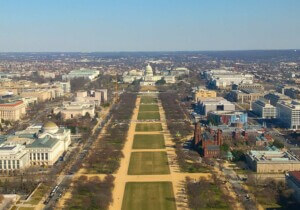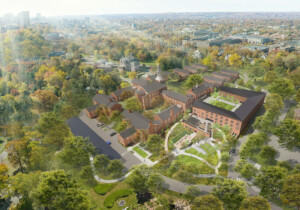Somewhere in the world right now, drivers and passengers are cursing their city’s traffic. The automotive snarls common in today’s metropolis are accepted as a symptom of modernity, but the traffic jam—as well as the battle between wheeled and foot traffic on city streets—is probably as old as the city itself. In fact, our forbearers dealt with it in many of the same ways that we’re attempting to now. To alleviate congestion in Rome, Julius Caesar implemented a version of road space rationing, forbidding carts and chariots to enter the city center before late afternoon. For bustling 15th century Milan, Leonardo da Vinci sketched an idea for road sharing system that separated pedestrian from wheeled traffic.
But the stakes of moving through the city were dramatically changed in the early 20th century with the debut of the car, a shift that provoked well-founded anxiety. “With all their speed forward, they may be a step backward in civilization,” Booth Tarkington wrote of automobiles in The Magnificent Ambersons, his 1918 novel that follows the beginnings of car culture. The multi-layered cost of cars and the infrastructure they require have come under intense scrutiny almost 100 years later, but one automotive company is hoping to be a leader in the conversation about what’s next. 2012 marks the second cycle in Audi’s Urban Future Award, a biannual competition that invites young architecture firms to contemplate what “mobility” could mean for cities in the year 2030.
This year Audi selected six teams in part based on each firm’s connection to a global metropolis—Tokyo, the Pearl River Delta, Istanbul, Mumbai, São Paulo, and the Boston-Washington corridor. The teams presented their final concepts in an exhibition in Istanbul October 12-26, and on October 18th the jurors heard presentations from each and selected a one winner. Boston-based Höweler + Yoon took home the prize (€100,000) for their scheme Shareway 2030, a futuristic proposal to bundle different types of transportation into a seamless, symbiotic whole. Maybe because the team was assigned a sprawling region rather than a city, thinking big—really big—came easily. Höweler + Yoon proposed not only innovations in transportation and infrastructure but also new paradigms for public spaces and social relations also based on sharing.
Here’s the premise: The American Dream is in crisis. The old model of individual ownership of a house and a car is passé—unsustainable, and, frankly, unappealing to future generations. So what might the new American Dream look like? Maybe something like “Boswash,” the team’s nickname for development along I-95 from Boston to Washington. The effective capital of Boswash is Newark, NJ, which becomes the site of a massive waterfront super hub where ships meet planes and high-speed trains. At points beyond the hub, energy generated by braking trains is used to charge pod-like Shareway cars, available for easy pick up at every train station. Cars and bikes aren’t the only shared amenities: so are houses (Sharestay). No matter where you are along the Shareway, you’ll never be far from a place to call home.
Sharing extends to the very fabric of the city as well. In the urban centers of Boswash, Shareway goes below ground but activates the streets directly above. The ubiquitous blacktop is replaced by a system called Tripanel, where three-in-one street surfaces rotate like billboards: paved road during certain times of day, turf-covered park at others, or, when the light is right, photovoltaic panels that capture solar energy. Some of the more challenged cities of Boswash are repositioned entirely (e.g. Baltimore, becomes a vast urban farm—Farm Share). “It requires imaginative design but also imaginative politics,” said Höweler + Yoon principal Eric Höweler of making his vision for Boswash a reality, noting that it would require a federal commitment on the scale of Eisenhower’s interstate highway system.
It’s a fantastical vision, to be sure, but also an optimistic and occasionally thrilling one. Shareway evokes previous bold statements about the city, from Lewis Mumford’s call to rethink the modern megalopolis, which he described as a “bursting container,” to MVDRV’s concept of the Evolutionary City, a city constantly made smarter through transparent use of technology.
Technology-enabled communication played a key role in other proposals, most notably that of Superpool, the Istanbul home team and local favorite. Called PARK, Superpool’s concept is essentially a loyalty program that builds on the city’s current transportation infrastructure, rewarding participation in transportation sharing with a stake in programming public space. “In Istanbul, streets are the true public space,” said Superpool principal Selva Gürdoğan. “Streets are democratic when you can own them, when you can change them.”
Based on the fact that the citizens of Istanbul are already heavy users of social media—if cities were ranked by Facebook users Istanbul, population 15 million, would come in second—PARK is managed through a social-media-style software program that advises on routes and also rallies like-minded people together for public events. For PARK, Superpool built on the firm’s established approach of data collection, analysis, and mapping. It’s something we often take for granted in the West, but the work is an important public service and means of instigating conversations about the city in a country where such information to date has not been readily available.
Both Shareway and PARK are highly specific to their assigned region or city but also contain bigger ideas that transcend a particular location. It may be this quality that the jurors found lacking in equally compelling concepts from Mumbai-based CRIT, NODE Architecture & Urbanism (Pearl River Delta), and Urban Think Tank (São Paulo), who just coming off a Golden Lion Award at the Venice Biennale. (The Tokyo team of Junya Ishigami + Associates, who in early previews was onto some interesting ideas of the city as an organic entity constantly regenerating itself, unfortunately dropped out before the final presentations.) In all the final proposals, cars, if anywhere to be seen at all, played second fiddle to grander scheme of good life in the city; cars become a means to an end rather than an end in and of themselves.
Of the winning proposal, Rupert Stadler, Chairman of Audi AG, said, “We’ll work with the winner to make a concrete project out of it.” This will take the form of a “city dossier,” a kind of blueprint that charts how a concept like Shareway could one day be realized. From Audi’s side of the table, it’s really a matter of facing the future—and the car’s place in it—head on. “I’m much more a fan of being active than defensive,” said Stadler. The German design consultancy Stylepark acts as curator for the award, which falls under an umbrella program called the Audi Future Initiative. Stylepark founder Christian Gärtner said, “With this city dossier we want to include other stakeholders, like real estate developers.” Noting that the Höweler + Yoon concept called for top down decisions while also engaging users, he added what could very well become a tagline for future competitions, “Cities are a joint effort of civilization.”
In the end, with meaty presentations from all the teams, it might have come down to who had the best images. While Superpool charmed with quirky animations and Urban Think Tank wove in a fictional love story, Höweler + Yoon offered up gorgeous renderings depicting a sleek and friction-free universe, one where an Audi logo would not be out of place. But cities of the future are likely to be assaulted not just by the traffic of increasing populations but also by the climate–witness hurricane Sandy’s recent impact on key Boswash hubs. It’s these rare moments of collective awareness that need to be seized upon to start conversations about how cities work in 2030 and beyond.
Click on a thumbnail to launch a slideshow of Höweler + Yoon’s proposal.










